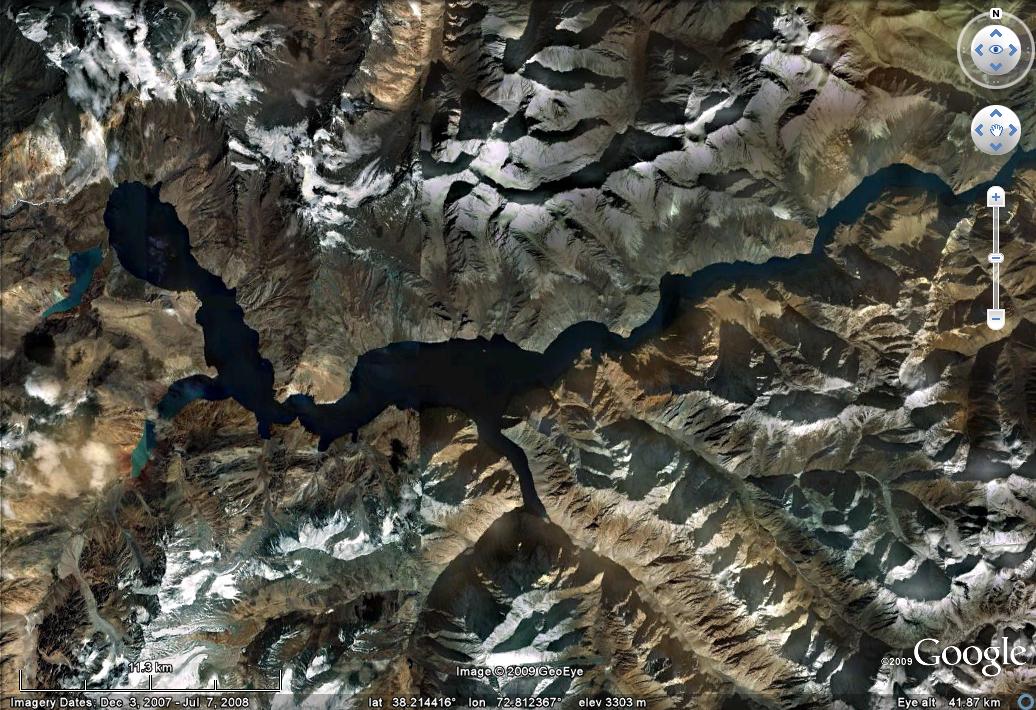20 December 2009
On the perils of Lake Sarez (Usoi) in Tajikistan
Posted by Dave Petley
Science this week has an article (Stone 2009) on the perils associated with Lake Sarez in the Pamirs. Sarez is a huge lake (56 km long and with a volume of 17 billion cubic metres of water) that was formed by a landslide triggered by the 1911 earthquake in Tajikistan (see image below).
 Google Earth image of the landslide dam at Usoi. The source of the landslide was to the north of the current deposit.
Google Earth image of the landslide dam at Usoi. The source of the landslide was to the north of the current deposit.The landslide dam (see image above) stands 567 metres tall. To put that in perspective, the image below shows Taipei 101, until recently the world’s tallest building. It is 501 metres tall:
 Taipei 101 (source Wikipedia)
Taipei 101 (source Wikipedia)Since its creation Lake Sarez has been steadily filling, which has long been a concern. There are an estimated 5.5 million people living downstream of the dam in the Amu Darya river valley, which flows through Tajikistan, Afghanistan, Turkmenistan, and Uzbekistan. There are really three key concerns with this dam:
- The dam could fail through seepage – a few years ago water started to seep through the landslide deposit, the concern is that this will erode out the core of the landslide;
- The dam could fail in an earthquake – this is a seismically-active zone, but the threat is considered to be quite low as the dam is considered to be quite stable;
- The dam could fail as a result of another landslide going into the lake, creating a displacement wave (similar to the Vaiont landslide) that causes the dam to overtop. Of course this is most likely to be triggered by an earthquake landslide.
The article points out that the third of these is the most likely, such that the site has a sizable warning system just in case.
The article points out that given the number of people downstream the risks are now considered to be too high. The dam itself cannot be stabilised, so there is a need to draw down the level of the lake by at least 50 m. However, there can be little doubt that this falls in the “easier said than done” category.
The key component of the article is highlighting that there are a range of views as to the level of danger at this site, both in terms of the possibility of another landslide and of the stability of the dam itself. The article quotes a number of notable landslide experts:
- Jorg Hanisch is quoted as saying that “the probability is 1 in a million,”of the dam being overtopped by a wave created by a landslide. He also rules out any possibility of the dame being eroded by seepage.
- Jean Schneider from BOKU in Vienna is quoted as saying that “The risk of even a partial outbreak is exaggerated…the dam will only possibly be overtopped in the far future.”
- On the other hand, Kadam Maskaev (deputy director of the emergency situations committee in Tajikistan) views the seepage in a different way: “The filtration regime of the dam is changing, and that makes me nervous.”
- Kyoji Sassa, the chair of the International Consortium on Landslides, has a different view again. The article claims that he argues that the threat from a further landslide is significant.
The suggested optimum mitigation approach is a diversion tunnel that would be used to generate hydroelectric power, with the water also being made available to downstream communities. However, the costs are high ($500 million) and such a project is not without risks. In the sort term it appears that there will be a research campaign that will culminate in a conference in 2011, the 100th anniversary of the dam. That would be an interesting meeting to attend!
Reference
Stone, R. (2009). Peril in the Pamirs Science, 326 (5960), 1614-1617 DOI: 10.1126/science.326.5960.1614



 Dave Petley is the Vice-Chancellor of the University of Hull in the United Kingdom. His blog provides commentary and analysis of landslide events occurring worldwide, including the landslides themselves, latest research, and conferences and meetings.
Dave Petley is the Vice-Chancellor of the University of Hull in the United Kingdom. His blog provides commentary and analysis of landslide events occurring worldwide, including the landslides themselves, latest research, and conferences and meetings.
It would be easier and quicker for them to build a pipe siphon using multiple pipes of large diameter than to tunnel.
Definitely all 3 of the scenarios listed are possible & that adds volumes (no pun intended) to the chances of an event occurring sooner rather than later. Also, there is no doubt that the earth barrier is waterlogged & you would have to think that in the event of a 7 or higher magnitude earthquake liquefaction is a definite possibility. If liquefaction occurs in that earth barrier then I have one word for you ! I know you know what that word is. One more thing, regarding the seepage.. I would expect the dam to fail within the next 15 years just from the seepage alone !
Definitely all 3 of the scenarios listed are possible & that adds volumes (no pun intended) to the chances of an event occurring sooner rather than later. Also, there is no doubt that the earth barrier is waterlogged & you would have to think that in the event of a 7 or higher magnitude earthquake liquefaction is a definite possibility. If liquefaction occurs in that earth barrier then I have one word for you ! I know you know what that word is. One more thing, regarding the seepage.. I would expect the dam to fail within the next 15 years just from the seepage alone ! To avoid this from happening I’d like to see the dam drawn down to at least the level of the seepage, that’s perhaps 350m.